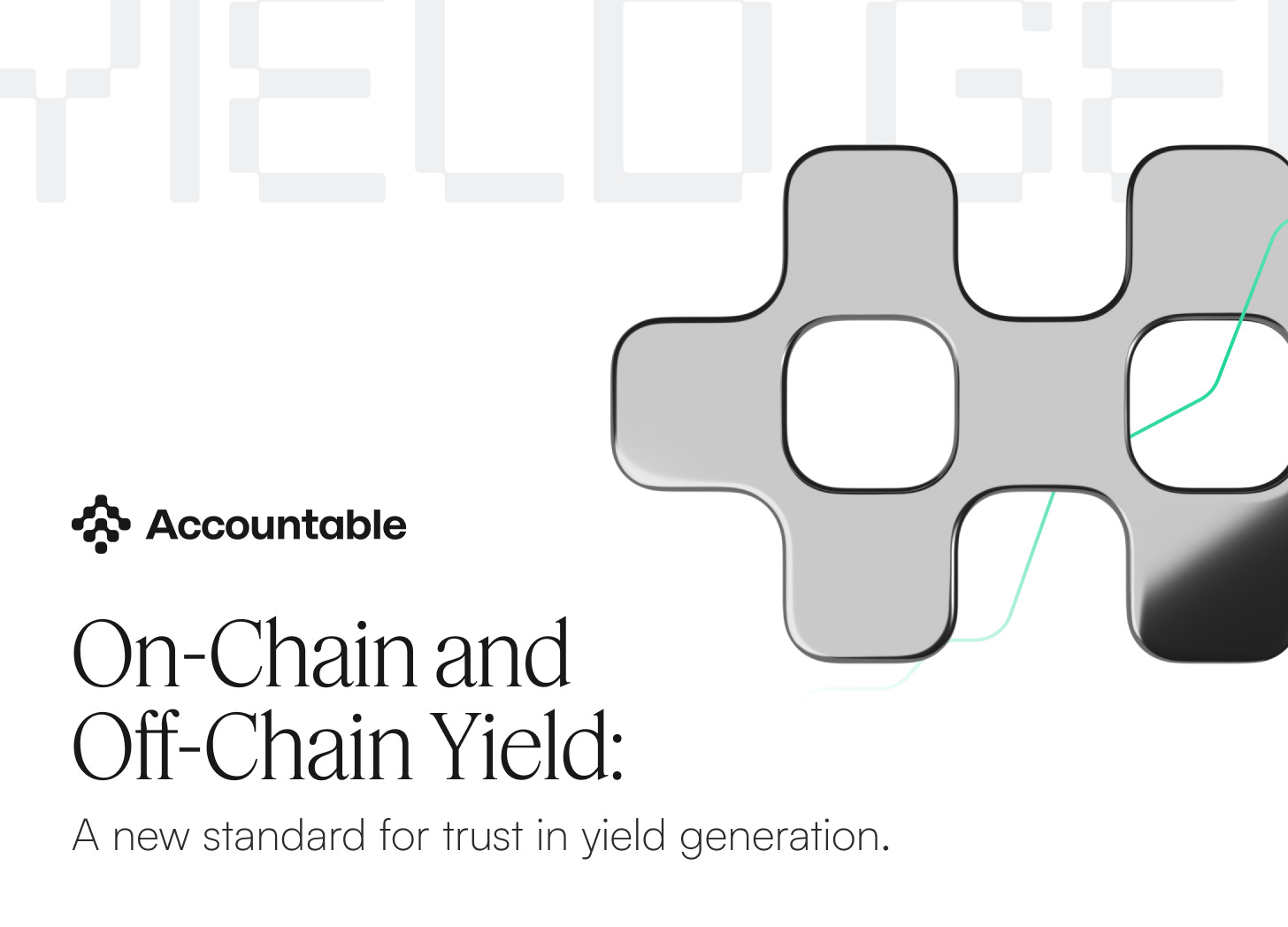Not All Yield Is Created Equal
Comparing Yield Models in Digital Finance
TL;DR
On-chain yield operates transparently through smart contracts, allowing anyone to verify collateral, interest, and performance in real time.
Off-chain yield depends on trusting centralized platforms and counterparties, with limited visibility and higher risk, as seen in past collapses.
Verifiable, real-time transparency is becoming the baseline for how capital flows into crypto yield opportunities.
In digital finance, not all yield is created equal. The way you earn interest on crypto assets can be broadly split into two paths: on-chain yield (through decentralized protocols on the blockchain) and off-chain yield (through centralized firms off the blockchain that issue digital representation of their activity/performance on-chain).
These two approaches might both promise attractive returns, but they operate on very different principles of trust, transparency, and risk.
On-Chain Yield: Trust The Code
On-chain yield refers to returns generated entirely through blockchain-based protocols. Simply put, you deposit your crypto into a decentralized finance (DeFi) smart contract and earn interest or rewards according to algorithmic rules.
Platforms like Aave and Compound allow users to lend cryptocurrency via smart contracts and earn interest automatically on-chain.
A defining strength of on-chain yield is real-time verifiability. Every loan, collateral deposit, and interest payment is recorded on a public ledger that anyone can inspect. Smart contracts enforce rules, such as requiring over-collateralization for loans, which means borrowers must lock in assets worth more than the loan amount to borrow. If collateral value falls too much, the contract triggers automatic liquidation to repay lenders, no human intervention required.
This setup proved resilient during the 2022 crypto crash. While many centralized lenders froze withdrawals or collapsed, DeFi platforms like Aave and Compound continued to operate, automatically liquidating risk according to their protocols.
Crucially, on-chain yield is earned in a trustless manner. “Trustless” doesn’t mean zero risk, but that users don’t need to trust a company or individual, they trust the code.
The on-chain model means anyone, anywhere can verify that yield is backed by actual activity, not just a promise.
Off-Chain Yield: Trust Me Bro The Company
Off-chain yield refers to returns offered by centralized platforms or counterparties that take custody of your crypto and invest it behind closed doors. You deposit assets, and in return, the platform promises an interest rate or profit share.
Programs like Gemini Earn, BlockFi, and Celsius operated like traditional banks or hedge funds. They pooled user deposits, lent them out, or traded with them, but all this activity took place off-chain, on private balance sheets. Users saw only a number in an app and had to trust it reflected reality.
This model can offer high returns, but it comes with high trust and limited visibility. In 2022, that risk became clear. Celsius froze withdrawals and filed for bankruptcy with a $1.2B hole. Gemini Earn users saw $900M locked up after Genesis, their lending partner, collapsed. BlockFi met a similar fate after exposure to FTX and other failed borrowers.
These failures shared a theme: users lacked visibility into reserves. Off-chain yield platforms offered little to no transparency. Many took on under-collateralized loans and leveraged bets behind the scenes. Without real-time data or collateral enforcement, users had no warning until it was too late.
Off-chain yield is “black-box” finance. And when the box breaks, everyone feels it.
Transparency vs. Trust
The contrast between on-chain and off-chain yield comes down to how they manage trust and risk.
Transparency: On-chain yields are fully transparent. Every transaction, collateral deposit, and interest calculation happens on a public ledger that anyone can inspect. Off-chain yields are opaque. Assets and liabilities sit on private books, and users often don’t see problems until it’s too late.
Trust model: On-chain systems rely on smart contracts. You trust code to do what it’s programmed to do, like liquidating over-collateralized loans automatically. Off-chain platforms require trusting people. You hand over custody and hope management acts responsibly, something that has failed repeatedly.
Risk and security: On-chain yield carries technical risk, like bugs or market crashes, but these risks are potentially visible and measurable. DeFi protocols have weathered major volatility without freezing funds. Off-chain platforms carry counterparty risk. Many loans were made without proper underwriting or risk controls, and when borrowers defaulted, users lost access to their funds. Legal risk was also higher, especially for unregistered products facing regulatory scrutiny.
The Strength of Real-Time Verifiability
One of the most significant advantages of on-chain yield generation are the real-time auditability and analytics platforms it provides. Because everything is on a public blockchain, the community, and independent analysts continuously monitor the major DeFi yield platforms. If there is any sign of trouble, say a large borrower on Aave nearing liquidation, it’s visible to everyone, and the protocol will act according to its code.
This radical transparency means there are no surprise black holes; funds aren’t secretly missing. In fact, after the turmoil of 2022, many in the crypto community pointed out that DeFi protocols like Aave, Compound, and Maker demonstrated their resilience by operating 24/7 without freezing user funds, even as trusted CeFi players went under. Code doesn’t panic, and it doesn’t lie, that’s a robust assurance in on-chain yield generation.
Smart contracts also mean programmatic trust. For example, if you deposit ETH into Compound, you know the exact rules that govern how you can withdraw it, what interest you’ll earn, and under what conditions a borrower might be liquidated.
There’s no scenario where a company insider secretly redeploys your ETH elsewhere or puts it in a risky bet without you knowing, the protocol simply doesn’t allow those actions outside of what’s coded. Of course, users must trust that the code is secure. Bugs or exploits are a risk, which is why reputable DeFi platforms undergo audits and extensive testing.
Nonetheless, once a contract is proven, it offers a level of predictability and security that no opaque institution can match. It’s the difference between knowing the rules of the game up front versus hoping the referee doesn’t cheat behind the scenes.
The Pitfalls of Opacity
Off-chain yield products may feel simple and familiar, offering APY in a straightforward interface, but their lack of transparency is a serious weakness. Users often have no idea where their funds are deployed. They could be lent to a market maker, staked in a DeFi yield farm, or pledged as collateral for another loan frequently, it’s a combination of all three.
Celsius, for instance, rehypothecated customer assets across multiple venues to chase higher yields, while presenting itself as a safe savings platform. That structure worked during a bull market, but when sentiment shifted, the interlinked bets unraveled quickly. Customers had no warning before withdrawals were halted, and by then it was too late.
In decentralized finance, smart contracts automatically liquidate undercollateralized positions, protecting lenders. In centralized finance, defaults turn depositors into unsecured creditors, leaving them stuck in lengthy bankruptcy proceedings. We have now seen multiple off-chain lenders go bankrupt, with users still awaiting partial recoveries.
There is also a deeper issue of trust. On-chain yield allows users to retain custody and transparency, with rules enforced by code. In off-chain yield, even if a company offers digital representations of its off-chain activity, these may still not offer meaningful guarantees if the underlying activity can be verified.
But while the transparency in on-chain yield is real, opportunities remain relatively narrow. The on-chain market today supports a limited set of yield strategies compared to the broader, more diverse off-chain landscape where products span everything from structured credit to real-world assets.
Bringing that diversity on-chain is the next step. To grow the ecosystem and bring in the next wave of users, not just circulate capital within the crypto space, we need verifiability. Without it, we risk repeating the same trust failures that led to the collapse of centralized finance (CeFi).
A Forward-Looking Future
The yield market is changing. After the events of the past few years, it's clear that the future of yield products depends on transparency that you can check in real-time.
We’re already seeing a convergence where even off-chain operations adopt on-chain elements to rebuild trust. Some centralized exchanges and lenders have begun publishing proof-of-reserves, which are cryptographic attestations of their holdings, to let users verify that their deposits are backed one-to-one. It’s a start, but the future likely goes further.
Imagine yield platforms where real-world assets (RWAs), such as treasury bills or loans, are tokenized on-chain. Even if yield is generated off-chain, ownership and accountability would still be recorded on a public ledger. Projects in DeFi are already bringing things like treasury yields on-chain in transparent wrappers, combining the reliability of traditional assets with the openness of DeFi.
DeFi protocols themselves are maturing. They’re adding more sophisticated risk controls, insurance funds, and governance. The track record speaks for itself, billions of dollars earning yield on-chain with no centralized custody and no runs on the bank. That model is proving both profitable and more accountable.
Since the crash of CeFi lenders, the focus has shifted to “don’t trust, verify.” Users want to understand how yield is made. Regulators are calling for more transparency. On-chain systems, with their built-in verification, are likely to lead the next phase of digital finance.
Whether yield comes from DeFi protocols or tokenized RWAs, the common thread is trust, grounded in real data, not promises. Verifiable transparency will become the standard, rather than a differentiator.
We are building the infrastructure to enable that shift.
About Accountable
Accountable is a digital finance platform that enables businesses to share data in a privacy-preserving way, and retail investors to access verifiable yield opportunities. We aim to remove trust barriers, reduce fraud, and unlock new opportunities for efficient and safe financial growth.
Join us on LinkedIn and X and make sure to sign up for the YieldApp waitlist as we rebuild confidence in crypto lending and borrowing.




